Understanding Serious Roach Infestation: Impacts and Solutions
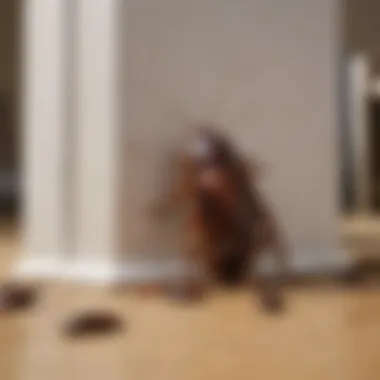

Intro
Roach infestations can rattle even the calmest household. When the unwelcome guests start making your space their own, understanding the problem becomes your first line of defense. It’s not just about getting rid of these pests; it’s understanding how they thrive and what keeps the population ticking. This article delves deep into serious roach issues, focusing on impacts, ways to recognize signs of an infestation, and practical measures for controlling and preventing these insidious creatures from taking over your home.
Preventive Pest Control Strategies
The adage, "an ounce of prevention is worth a pound of cure," rings true especially when it comes to pest control. Taking measures to deter roaches before they cozy up to your leftovers can save you a heap of trouble down the road. Here’s how to fortify your castle against cockroaches.
House Exterior Protection
Tips for sealing cracks
Roaches are crafty little sods, sneaking into homes through the tiniest of openings. To keep them at bay, inspect the exterior of your house for cracks and crevices. Seal up gaps around windows and doors with caulk, and don’t skimp—use foam insulation for larger openings. A little labor now can stave off a world of pain later.
Clearing debris
A cluttered yard can be a buffet for pests. Make it a habit to regularly clear away leaves, branches, and any other debris you’ve accumulated. Not only does this enhance your home’s appearance, but it also minimizes the hiding spots for roaches and other pests. A tidy yard is a happy yard!
Preventing pests from entering
Installing door sweeps on exterior doors and screens on windows can act as a second line of defense. These simple enhancements can drastically reduce the chances of unwelcome visitors.
Yard Maintenance
Essential yard care routines
Taking care of your yard isn’t just about aesthetics; it’s a crucial aspect of pest control. Regularly mow your lawn, trim back overgrown foliage, and maintain your flower beds. When the yard looks well-kept, it sends a clear message to pests that it’s not the place to hang out.
Methods for keeping yard pest-free
Consider adding gravel around the foundation; it not only looks neat but also helps deter pests. Furthermore, you might want to plant certain herbs like mint and basil, which can help keep them guessing.
Indoor Cleanliness
Expert cleaning tips and techniques
Cleanliness is next to godliness, they say, and it’s true in pest control too. Regular vacuuming can help pick up crumbs, and wiping down surfaces will remove any potential food sources. Pay special attention to hidden areas like behind the fridge and under the sink.
Maintaining a pest-resistant indoor environment
Store food in airtight containers and always keep your kitchen tidy. Ensure that your pantry is organized to reduce clutter and eliminate potential hotspots that roaches might find inviting.
Garbage Disposal
Efficient waste disposal methods
Garbage is a buffet for roaches if left unchecked. Use bins that fit securely with tight lids. It’s wise to take out the trash regularly rather than letting it pile up.
Importance of proper garbage disposal
Not only does proper disposal habits maintain your home’s cleanliness, but it also staves off pests. Don't forget to rinse out containers before tossing them away, as leftover food can attract a variety of pests.
Other Pest Prevention Strategies
Innovative ways to safeguard your home
Consider adding plant-based barriers, like peppermint oil, which can naturally deter roaches and other pests. Not only do these methods keep your home safe, but they can also add a nice aroma to your living space.
Identifying Pest Risk Areas
Even with preventive tactics, understanding pest risk areas is crucial. This can help you catch potential infestations before they become a real headache.
Moisture Prone Areas Inspection
Identifying damp conditions
Roaches love humidity. Regularly check your bathroom and kitchen for any plumbing leaks or water accumulation. A damp towel left on the floor can turn into a roach hotel before you know it.
Tips for preventing infestations
Install exhaust fans in moisture-prone areas. You can also use silica gel or moisture-absorbing crystals to keep the space dry.
Crack and Crevice Inspection Guide
Importance of inspecting access points
Roaches take advantage of small entryways. Conduct routine checks in places like baseboards, under sinks, and behind appliances to identify any gaps.
Strategies for sealing cracks and crevices
Once identified, use caulking and expanding foam to seal these points effectively, ensuring that roaches can’t wiggle their way in.
Greenery Inspection for Pest Risks
Understanding greenery's impact on pests
As much as plants beautify your surroundings, they can also draw pests. Check for any nesting areas or overgrown plants that might be sheltering these uninvited guests.
Guidelines to maintain pest-free yards
Regularly prune hedges and oversee garden debris to maintain a pest-free environment.
Additional Pest Risk Areas
Miscellaneous pest risk areas and preventive measures
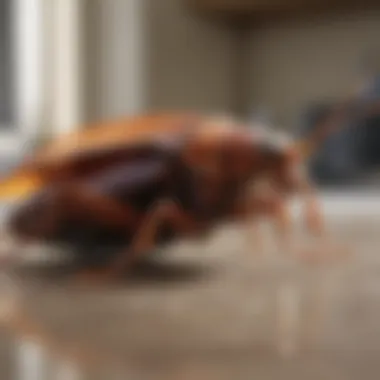
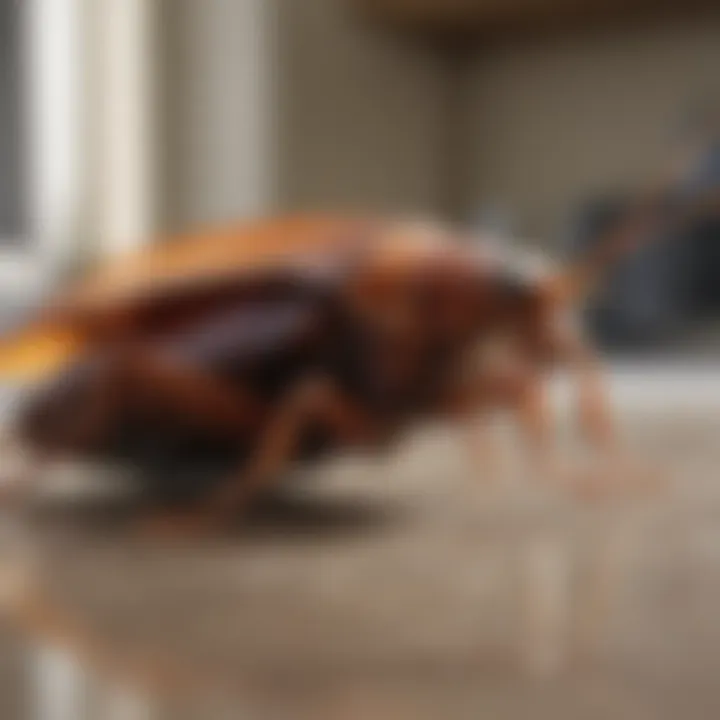
Don’t forget to check your garage and attics as pests often find their way into those less frequented spaces. Using traps in such places can help you monitor any unexpected visits.
"Proactive pest management is the smartest route to a peaceful home."
Implementing these preventive strategies can help keep roaches at bay, reducing exposure to potential health risks and maintaining a cleaner living environment.
Prelude to Roach Infestations
When it comes to household nuisances, roach infestations stand out dramatically. They are not just mere inconveniences; they represent a deep-seated problem that can have serious implications for those involved. Understanding the basics of roach infestations is vital. It allows homeowners and renters alike to recognize potential issues before they escalate, ensuring more effective prevention and management tactics.
Defining Roach Infestation
Roach infestation typically refers to a situation where these unwanted pests, cockroaches, establish a substantial presence in a specific area, often within homes or commercial properties. Defining infestion goes beyond just spotting a couple of these critters scuttling about, it involves an evaluation of their numbers, nesting habits, and activity patterns. For example, a single sighting might not raise alarms, but a consistent presence of adults or baby cockroaches indicates an urgent issue that requires attention.
It's essential to distinguish between occasional visits from a roach and a full-blown infestation. A few cockroaches here and there may suggest that your home is being infiltrated rather than implying a significant health hazard. On the other hand, constant sightings may warrant serious action as roaches can reproduce rapidly. The German cockroach, for instance, is notorious for its incredible multiplication rate, where a single female can give rise to hundreds in just a few months. Understanding this definition can guide the steps you take to handle the problem effectively.
Significance of the Issue
The significance of serious roach infestations cannot be overstated. Kosd much more than just being creepy-crawlies, these pests can dramatically affect both health and peace of mind in a household.
"An infestation can grow exponentially and lead to severe repercussions, from hygiene concerns to psychological distress."
For house owners and especially those with children or allergies, cockroaches become more than unpleasant guests. They are associated with various allergens and can trigger asthma attacks. Knowing this highlights the importance of quick identification and action. Beyond health risks, roaches can contaminate food and surfaces with harmful bacteria, complicating what might initially seem a small problem into a colossal headache.
Moreover, from a property standpoint, an infestation can degrade the value of a home. Damages caused by these unwelcome invaders, such as droppings or odors that are hard to remove, can make a home less appealing to potential buyers down the line.
In summary, tackling roach infestations head-on is akin to addressing an iceberg; what lies beneath the surface is often far more concerning than what one initially spots above water.
Types of Cockroaches
Understanding the different types of cockroaches is crucial for effectively addressing a roach infestation. Not all cockroaches behave the same way, and their unique characteristics can play a significant role in how an infestation develops. Identifying the specific species can lead to more targeted control strategies and better management practices. Each species has its own habitat preferences, reproductive behaviors, and ability to survive in varied environments, which can profoundly influence how they proliferate in our homes and communities.
Common Species
Within the world of cockroaches, several species are particularly notorious for invading homes. Here are some of the most common:
- German Cockroach: One of the most prevalent species in urban settings, the German cockroach tends to thrive in kitchens and bathrooms due to the availability of food and moisture. They are small, around half an inch long, and are light brown with two distinctive dark stripes on their back. Their rapid reproduction rate exacerbates infestations.
- American Cockroach: This larger cockroach can grow up to three inches long and has a reddish-brown color. Preferring outdoor environments or basements, they can often infiltrate homes during summer months. Their resilience and ability to survive on various food sources make them a formidable foe in pest control.
- Oriental Cockroach: Dark brown or black in color, these cockroaches prefer cooler, damp areas like basements. They are slower movers compared to their counterparts and can often go unnoticed until populations explode.
- Brown-banded Cockroach: As their name suggests, these cockroaches have distinctive light tan bands across their wings and are often found in drier areas of homes. Their preference for high temperatures means they can commonly be located in warmer spots like electrical appliances and machinery.
Each species can impact the home environment differently. Understanding their habits can help homeowners to act proactively rather than reactively.
Habitat Preferences
Cockroaches are notorious scavengers, but they have specific habitat preferences that guide their infestations. Effectively managing and preventing these pests requires knowledge of where they tend to thrive.
- Moist Areas: Most cockroach species are drawn to moisture-rich environments. This includes kitchens, bathrooms, and even laundry rooms where dampness is prevalent. Cockroaches can often be found hiding behind sinks, under refrigerators, or in plumbing areas.
- Food Sources: Cockroaches are omnivorous and opportunistic feeders. They will take advantage of any food source, from crumbs on the floor to improperly stored pantry items. Places like the pantry or places where food is stored must be kept clean and organized to reduce the odds of attracting these pests.
- Sheltering Conditions: Enhanced hiding spots boost their likelihood of proliferation. Cluttered areas, including piles of newspapers, outdated appliances, or stacks of cardboard boxes, can provide ideal nesting conditions for cockroaches. They prefer to stay hidden away, only foraging for food and moisture when it is dark.
Recognizing habitat preferences helps to eliminate potential breeding grounds and barriers to access, which can significantly decrease roach populations before they become a serious infestation.
"Knowing your enemy can make all the difference in the battle against cockroaches."
By employing attentive home management techniques and maintaining cleanliness, readers can greatly reduce the appeal of their homes to various types of cockroaches.
Health Risks Associated with Roach Infestations
Roach infestations are not just a nuisance; they can present serious health risks that impact the lives of those within a household. It is essential to grasp the importance of understanding these risks, as they can affect health and wellbeing—especially for vulnerable populations like children and the elderly. With cockroaches often lurking in unseen corners, their presence can trigger a range of health issues that may be overlooked until they escalate.
Allergic Reactions and Asthma
Cockroaches are known to produce allergens that induce allergic reactions in many individuals. These allergens are found in their saliva, feces, and body parts. When inhaled, they can lead to respiratory problems, especially for those who already suffer from conditions like asthma. For instance, imagine a child who develops a persistent cough or difficulty breathing, only to later find out that the cause is linked to exposure to cockroach allergens.
The symptoms—runny nose, itchy eyes, or even skin rashes—can be severe enough to warrant medical attention. Long-term exposure may even increase the likelihood of developing asthma. According to various studies, children in homes with cockroach infestations tend to have noticeably higher rates of asthma.
"Studies have shown that children exposed to cockroach allergens are almost twice as likely to develop asthma symptoms and require hospitalization."
Disease Transmission
The potential for disease transmission is another serious concern associated with roach infestations. Cockroaches are scavengers by nature and will eat just about anything, which may include disease-causing pathogens. They often traverse garbage, decaying organic matter, and even sewage, leading to contamination of surfaces and food within homes.
Some of the diseases associated with cockroaches include:
- Salmonella: This bacterium can lead to food poisoning, causing symptoms like nausea and diarrhea.
- E.coli: Known for being a serious contaminant of food and water, it can cause significant gastrointestinal distress.
- Gastroenteritis: Infections from cockroach-contaminated food can lead to inflammation of the stomach and intestines.
- Typhoid Fever: Though less common, roaches can play a role in the transmission of this potentially life-threatening disease.
Understanding these health risks associated with cockroaches underscores the need for effective infestations management. By recognizing the dangers posed by these pests, homeowners can take proactive measures to create a healthier living environment.
Signs of a Serious Roach Infestation
Identifying the signs of a serious roach infestation is crucial for any homeowner. When a roach problem arises, it is not merely an aesthetic concern; it represents potential health hazards and environmental implications. Being aware of the signs early on can help prevent a minor issue from escalating into a full-blown infestation. Understanding these indicators empowers homeowners to take swift action, ensuring not only their health but also the comfort of their living spaces.
Visual Indicators
Visual clues play an essential role in identifying the presence of cockroaches. These pests are nocturnal and tend to hide during the day, making their physical appearance less frequent. However, some signs are hard to miss.
- Droppings: Roach droppings resemble small, dark grains of pepper or coffee grounds. They are often found near food sources, nesting areas, or along walls and floors where roaches travel. If you spot these, it’s a telltale sign of an infestation.
- Cast Skins: As cockroaches mature, they shed their skins. These shells, roughly the same size and shape as the roach itself, can be located in areas where roaches love to hide, such as under sinks or kitchen cabinets. The sight of these skins indicates the presence of multiple roaches in your space.
- Egg Cases: German cockroaches, for example, are known to carry egg cases, or oothecae, that can be found in dark, secluded places. Each case can contain dozens of eggs, increasing the likelihood of a significant infestation if not addressed quickly.
- Live Roaches: Of course, spotting a live cockroach, especially during the day, is alarming. This indicates that the infestation is severe and that immediate steps should be taken to resolve the issue.
Recognizing these visual indicators quickly can lead to effective management before the problem spirals out of control.
Odors and Stains
Another significant aspect of identifying a serious infestation involves the olfactory senses. Cockroaches emit a distinct, oily odor that can sometimes be detected even before the creatures themselves are seen. This musty smell often intensifies in areas where they are nesting or congregating.
- Musty Smell: If a room carries a strong, unpleasant smell reminiscent of decaying fabric or a musty basement, it's time to investigate. The odor seems to linger more in kitchens or bathrooms where moisture is present and food might be accessible.
- Staining Problems: In addition to the smell, you may notice dark stains and streaks on surfaces. These stains arise from roach feces and other bodily fluids. If left uncleaned, they can contribute to larger hygiene problems.
- Grease Marks: Cockroaches often leave behind greasy marks on walls and surfaces upon exposure and movement. These marks can signify a heavy traffic area for the pests and should be addressed immediately.
If you smell something off or see unusual stains, these could be more than just minor inconveniences. They signal an urgent need for action.
Monitoring for both visual cues and odors can provide homeowners with a clear picture of the level of infestation. Understanding these signs facilitates timely action and can significantly reduce the health risks associated with serious roach problems.
Environmental Factors Contributing to Infestations


Understanding the environmental factors that lead to roach infestations is key in tackling the issue effectively. These elements not only provide insight into why infestations occur, but they also guide homeowners on how to prevent them from taking root. Without accounting for these aspects, controlling the infestation becomes like trying to stop a flood with a sieve.
Moisture and Humidity
Roaches are notorious for thriving in moist environments. High humidity levels create the perfect breeding ground for these pests. Cockroaches require water to survive, and they are often drawn to areas like kitchens and bathrooms, where moisture tends to accumulate. Even small leaks can become an attractive oasis for them.
- Check for leaks: Any drip from pipes or faucets can provide enough moisture for a significant population growth.
- Humidity control: Utilizing dehumidifiers or air conditioning can significantly reduce humidity levels and discourage roach presence.
- Ventilation: Ensuring good ventilation in your home can help maintain dry conditions, making it less inviting for these pests.
Taking steps to manage moisture may feel tedious, but it pays off. Households can prevent potential infestations before they start, fostering a healthier living space.
Food Source Availability
Food accessibility is another strong factor in attracting roaches. These pests are opportunistic feeders, meaning they’ll seize almost any opportunity to snag a meal. Leaving crumbs on the counter or half-opened food packages can be like lighting a beacon: “Dinner is served!”
- Proper food storage: Sealing food in airtight containers is a simple yet effective way to cut off a food supply.
- Cleanliness is next to roach-less: Regular cleaning of surfaces and vacuuming can eliminate food particles. Remember, one crumb is a feast for many roaches.
- Rethink pet food: Don’t forget about your furry friends. Leaving pet food out overnight is a free buffet for uninvited guests.
By becoming mindful of food management, the chances of attracting roaches drop significantly. Moreover, it contributes to a cleaner, more organized living space.
Sheltering Conditions
Cockroaches are experts at hiding. They seek out nooks and crannies to make themselves at home, and if your house has plenty of hiding spots, you might be unknowingly inviting them in. They love dark areas, especially where they can find warmth and protection from disturbances.
- Seal cracks and crevices: Take a walk around your home and look for any gaps around windows and doors. Sealing these openings blocks entry points for roaches.
- Declutter: The more stuff lying around, the more chances roaches have to find a cozy spot to settle in. By reducing clutter, it’s easier to spot signs of infestation and makes the environment less appealing for them.
- Inspect outdoor conditions: Roaches also prefer to make their entry from the outside. Ensure that gutters are clear, and landscaping does not foster humid conditions where they can breed.
Remember: Keeping environments inhospitable for these creatures is crucial. If you’re proactive about these environmental factors, you take a giant leap toward a roach-free home.
Understanding these factors allows homeowners to take control of their spaces effectively and, ultimately, to prevent infestations from ever taking hold. With some diligence and the right strategies in place, a clean, safe living environment can be achieved.
Biological Characteristics of Cockroaches
Understanding the biological characteristics of cockroaches is crucial for a comprehensive grasp of serious infestations. These creatures, often dismissed as mere nuisances, possess fascinating and complex traits that contribute significantly to their survival and proliferation in human habitats. Knowing what makes cockroaches tick can aid homeowners in developing targeted strategies for identification and mitigation.
Reproductive Behavior
Cockroaches are known for their prolific reproductive habits. A single female can produce an astounding number of offspring over her lifespan, sometimes reaching up to 300 eggs in various batches. This reproductive potential amplifies the urgency in controlling infestations. Most species lay eggs encased in a protective structure called an ootheca, which serves to shield them from environmental threats, ensuring that even in seemingly hostile settings, new generations can thrive.
- Egg cases are typically brown and oval-shaped, and that makes them tough to spot. Depending on the species, these cases may be dropped before hatching or carried until the young are ready to emerge.
- Mating habits are also intriguing; male cockroaches engage in courtship rituals that can last several minutes, and successful encounters lead to quick fertilization and reproduction.
"Understanding cockroach reproductive behavior is like peering into a dark corner of a room: the more you know, the better equipped you are to eradicate the hidden sources of an infestation."
Lifespan and Growth Stages
In terms of lifespan, cockroaches undergo a fascinating metamorphosis. From egg to adult, they experience several nymphal stages, during which they resemble miniature versions of adults but lack fully developed wings and reproductive organs. Their growth stages can span weeks to months depending on environmental conditions such as temperature and food availability.
- Egg: The journey begins in the egg stage, where an ootheca is laid. The time taken for eggs to hatch varies with species.
- Nymph: When a cockroach hatches, it emerges as a nymph. Feeding and molting occur several times until the final stage. Each molt makes them more substantial and gives them a more adult-like appearance.
- Adult: After about five to seven molts, they reach maturity. Adult cockroaches can live from several months to a few years.
It’s essential to recognize these growth stages because identifying them can help in assessing infestation severity and tailoring management approaches accordingly. For instance, controlling nymphs can prevent the rapid culmination of adults, which leads to further reproduction.
Assessment of Infestation Severity
Understanding the severity of a roach infestation is fundamental for any homeowner or caretaker facing this hidden menace. Knowing how to assess the situation can mean the difference between a minor nuisance and a full-blown health hazard. When it comes to managing such infestations, the first step often involves determining just how bad the problem is. This assessment not only helps in targeting removal efforts but also sets the tone for long-term prevention. Proper evaluation leads to effective action, which can save time, money, and resources.
Methods of Evaluation
There are several methods to evaluate the severity of a roach infestation. The primary ones include:
- Visual Inspections: Begin with a thorough inspection of your premises. Look for signs like droppings, egg cases, and shed exoskeletons in areas where cockroaches are likely to hide, such as kitchens and basements.
- Monitoring Traps: Setting up sticky traps can provide insight into roach activity and numbers. These traps not only capture roaches but can also highlight high-traffic areas.
- Professional Assessment: Sometimes, it may be worth calling in a pest control professional. They can identify all kinds of cockroaches, assess the scale of the infestation, and suggest a tailored plan.
It's crucial to use a combination of these methods for a complete picture. Relying solely on one approach can lead to underestimating or overestimating the problem.
Understanding Infestation Levels
Once you've conducted your evaluations, it’s vital to assess the level of infestation. Cockroach infestations can be classified into several stages:
- Sporadic Presence: A few sightings or droppings are evident. Typically, this stage could be handled with preventive measures and simple traps.
- Low-Level Infestation: At this stage, there's more consistent evidence of roaches. You may find their droppings, egg cases, or some live insects. This indicates it's time for more strategic, active mitigation efforts.
- Moderate Infestation: A noticeable presence is observed, likely resulting in both health risks and discomfort. This level may require intervention with insecticides and a thorough cleaning of affected areas.
- Severe Infestation: When you’re seeing multiple roaches during the day or find them in living areas, it’s a strong indicator of a serious problem. This situation requires immediate professional pest control to tackle the issue effectively.
"A stitch in time saves nine." – This age-old adage holds true in pest management, as early detection can prevent a full-scale crisis.
Recognizing these levels allows homeowners to act swiftly and appropriately. Detail-oriented strength thus goes hand-in-hand with responsive action, creating a more effective strategy against roach infestations. Once this assessment has been conducted, decisions can be made to implement control measures accordingly.
Integrated Pest Management Strategies
Integrated pest management (IPM) strategies play a crucial role in tackling roach infestations. They combine various techniques and practices that are designed to minimize the risk of infestation and manage populations effectively.
The essence of IPM lies in its holistic approach. Rather than simply reaching for pesticides as a first response, IPM emphasizes understanding the complex behaviors of cockroaches and their environment. This enables homeowners to take informed actions and reduce chemical dependencies, which can be harmful both to health and the ecosystem.
Prevention Methods
Prevention is the backbone of any successful pest management strategy. Here are several techniques that can be employed:
- Seal Entry Points: Just like blocking the doors of your house, sealing cracks and gaps where roaches can crawl in is essential. Pay special attention to areas around pipes, vents, and electrical outlets.
- Maintain Cleanliness: A clean environment inhibits roach activity. Scrub kitchen surfaces and vacuum floors regularly to remove crumbs and residue. Don’t forget to keep food sealed in airtight containers.
- Reduce Moisture: Roaches thrive in damp environments. Look for leaks under sinks and fix them. Using dehumidifiers can also help to keep moist levels low, making your home less appealing to these unwelcome guests.
- Use Natural Repellents: Sprinkling food-grade diatomaceous earth in suspected areas can create barriers as it is harmful to roaches, offering a non-toxic preventive measure.
Active Management Techniques
When prevention fails, active management techniques become essential. These are some options to consider:
- Trap Placement: Using sticky traps effectively can catch roaches while providing a progress report of infestation severity. Place traps in high activity areas such as under sinks or behind appliances.
- Boric Acid Application: A well-known method is using boric acid, which can be sprinkled in areas where roaches wander. It’s a slow-acting poison, so roaches take it back to their nests, impacting more of them over time.
- Professional Pest Control: Sometimes, the most effective approach may be to call in professionals. They often have access to specialized tools and knowledge for handling significant infestations, ensuring the problem is tackled without exacerbating it.
"Effective management of roach infestations requires understanding both the roaches and the environment in which they thrive. As the saying goes, an ounce of prevention is worth a pound of cure."
By employing both prevention methods and active management techniques, every homeowner can navigate the complexities of serious roach infestations, ultimately regaining control over their living spaces.
Chemical Control Options
When it comes to tackling a serious roach infestation, chemical control options often serve as a vital part of the larger strategy. Utilizing these methods can provide immediate relief and significantly reduce the population of these persistent pests. However, it’s essential to understand the nuances involved in selecting the correct products and employing them effectively. Proper use of insecticides can make the difference between a temporary fix and a lasting solution.
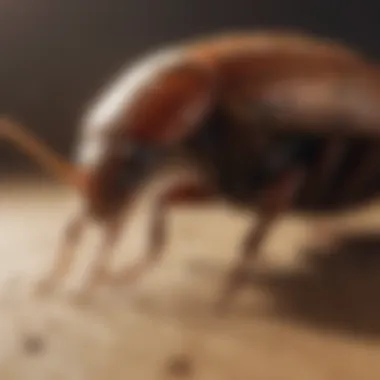
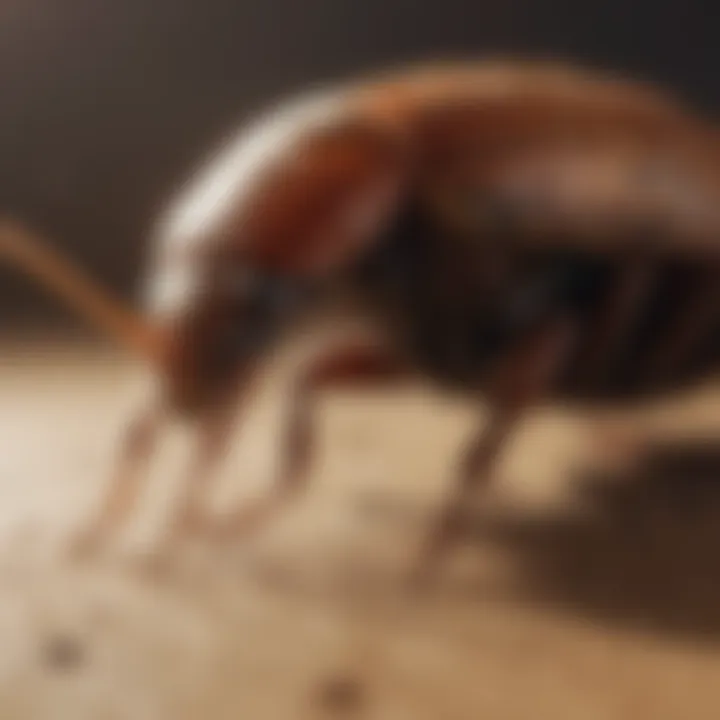
Insecticides and Their Use
Insecticides can be categorized into several types, including sprays, baits, and dust formulations. Each type has its pros and cons, and knowing the right one to choose is critical:
- Sprays: These are often used for direct applications and can quickly kill cockroaches on contact. However, they might not penetrate hard-to-reach areas where roaches hide.
- Baits: These contain attractive ingredients mixed with slow-acting insecticides. They lure the roaches, which then take the poison back to their nests, effectively wiping out a larger number of pests. This method provides a more thorough approach over time, though it may take longer to notice results.
- Dusts: These formulations can be applied in cracks and crevices where sprays can’t reach. The powder clings to the roaches' bodies and is ingested when they groom themselves. Dusts can be effective but require careful placement to avoid exposure to pets and children.
Understanding the behavior of cockroaches—such as where they tend to hide and how they interact with these substances—is fundamental for effective application.
"Chemical control is not a standalone solution, but rather a part of integrated pest management."
Safety Considerations
Using chemical products also comes with its own set of considerations that homeowners should be keenly aware of. While insecticides can be effective, improper application could pose risks to both health and the environment. Here are critical safety aspects to take into account:
- Read Labels Carefully: Always follow the manufacturer's instructions regarding application and dosage to minimize any risk.
- Ventilation: Ensure the area is well-ventilated during and after applying any products. This is particularly important if using sprays, as chemicals can linger in the air.
- Avoiding Contact: Keep children and pets away from treated areas until it is safe to return, as per the product's guidance.
- Protective Gear: Use gloves and masks when handling insecticides to avoid direct exposure to the skin or inhalation of fumes.
Remember that while chemical options can quickly alleviate an infestation, they should be used judiciously within the context of an overall pest management plan. Combining them with non-chemical strategies, such as proper sanitation and habitat modification, leads to more sustainable results.
Non-Chemical Control Approaches
Addressing serious roach infestations goes beyond just chemical treatments. Many homeowners are now turning to non-chemical methods for pest control due to concerns about health risks associated with chemical exposure as well as the desire for safer homes. Non-chemical control approaches are significant because they not only aim to eliminate the existing cockroaches but also work to create an environment that is unwelcoming to future infestations.
Using such strategies can be both cost-effective and environmentally friendly. It often involves some elbow grease, but the benefits outweigh any temporary inconvenience. Let's dive into two noteworthy non-chemical tactics: physical barriers and traps, and the utilization of natural predators and deterrents.
Physical Barriers and Traps
Physical barriers serve as the frontline defense against cockroach invasions. Think of it as the fortifications around your home – they keep unwanted guests out. One effective method is sealing cracks and crevices where cockroaches might enter your home. You can use materials like caulk or silicone to cover gaps around windows, doors, pipes, and even baseboards.
Additionally, traps can be incredibly useful. There are many kinds of traps available, ranging from simple sticky traps to more advanced bait stations. Sticky traps can be placed in areas where you've seen roaches, like behind appliances or in dark corners. They work silently but effectively, helping to monitor and catch roaches. Make sure to check these traps regularly, disposing of any roaches caught and replacing the traps as needed.
Here’s a quick list of strategies:
- Seal Up: Fill in all cracks and crevices in your home.
- Traps: Employ sticky traps to gauge the extent of the infestation.
- Regular Cleaning: Always keep food sealed and surfaces clean to deter them from sheltering in your home.
“An ounce of prevention is worth a pound of cure.” The effort you put into these physical barriers today can save you from a much larger headache tomorrow.
Natural Predators and Deterrents
Using nature to combat pests is an age-old strategy. Some animals can act as natural deterrents against roach populations. For instance, geckos and some species of spiders are known to prey on cockroaches. Encouraging an environment that attracts these natural predators can help keep cockroaches in check. However, be cautious; introducing new species can also lead to unforeseen complications in your home ecosystem.
Equally helpful are deterrents derived from natural ingredients. Some homeowners have found that substances like peppermint oil or diatomaceous earth can keep cockroaches at bay. Sprinkling food-grade diatomaceous earth around the areas where cockroaches are likely to roam can work wonders. This powder, made from tiny fossilized algae, is dehydrating to roaches when they come into contact with it.
To sum up, here’s a handy checklist for natural deterrents:
- Attract Predators: Encourage beneficial creatures like geckos to enter your yard.
- Utilize Natural Deterrents: Use peppermint oil or diatomaceous earth in key areas.
- Clean Up: Maintain a clean environment that lacks food sources for cockroaches.
Long-Term Solutions for Prevention
Dealing with roach infestations requires more than just immediate solutions; it calls for a long-term commitment to prevention. The old saying, "an ounce of prevention is worth a pound of cure," rings especially true when it comes to managing cockroach populations. Roaches are not just pesky nuisances; they pose health risks that can linger long after the initial infestation is dealt with. A solid prevention strategy ensures that these unwelcome guests don't come knocking again.
By focusing on ongoing upkeep, homeowners can establish environments that actively discourage roaches from taking up residence. Regular maintenance and keen observation are key. The benefits of these long-term solutions not only enhance home safety but also provide peace of mind. They'll keep your space clean and promote a healthier living environment.
Regular Inspections
Conducting regular inspections is paramount in the fight against crocodile-like cockroaches. A thorough examination of your property enables you to catch any signs of infestation before they snowball into a full-blown crisis. Look for common indicators, such as droppings, egg cases, and even the unpleasant odor they tend to leave behind. It's wise to check areas where food is stored and other humid parts of the home like kitchens and bathrooms.
- Frequency: Aim for at least once a month. Make it a routine, like paying bills or getting groceries.
- Tools: You don’t need fancy gadgets; just a good flashlight and a bit of patience will do the trick.
- Health Implications: Early detection might also save your family from potential allergic reactions or diseases.
Being proactive with inspections means less time worrying about serious damages. More than that, it positions you to address potential infestations before they’re able to set up shop in your home.
Creating an Inhospitable Environment
Making your home inhospitable to pests is essential in reducing roach populations. After all, if there's nothing to eat, drink, or hide behind, they'll likely pack up and leave. Focus on these specific strategies:
- Seal Entrances: Investigate for any gaps or cracks in walls, windows, and doors. Use caulk or weather stripping to fill these, making it tough for roaches to infiltrate.
- Declutter: Keep piles of newspapers, cardboard, and other debris to a minimum. Roaches love clutter. By clearing the way, they’ll have nowhere to hide.
- Food Storage: Make sure food items are stored in airtight containers. This might seem basic, but you'd be surprised how often this oversight occurs.
- Moisture Control: Fix any leaks and ensure proper ventilation in damp areas of your home. Roaches thrive in moist environments, so reducing humidity can work wonders.
- Regular Cleaning: Sweep, mop, and vacuum regularly, especially under appliances where food particles can sneak away.
Creating an inhospitable environment is not just about maintaining cleanliness—it's about fostering a home ecosystem that simply doesn't appeal to cockroaches. Keep in mind that it takes work, but it is a much easier route than battling a full infestation every few months. Getting on the front foot with these practices will leave your home far less attractive to any wriggly intruders.
Role of Professionals in Addressing Infestations
When faced with a serious roach infestation, many homeowners may feel overwhelmed. It’s not just a matter of spotting a few critters here and there; the presence of cockroaches signifies much more. The complexities of their biology, coupled with their rapid adaptability, can make DIY approaches insufficient. This is where the role of professionals becomes paramount.
Professional pest control services possess specialized skills and knowledge that can address infestations promptly and efficiently. They offer a systematic approach to exploring the underlying causes of an invasion, which can often go unnoticed by the average homeowner. By diagnosing the severity of the situation, professionals can tailor their treatment strategies accordingly, reducing the risk of potential health hazards associated with roaches.
When to Seek Professional Help
Determining the right moment to reach out for professional assistance can often be daunting for homeowners. Here are key indicators that it's time to make that call:
- Exceeding DIY Solutions: If your home remedies and traps haven't yielded results after several attempts.
- Visible Signs of Infestation: The sight of several roaches, notably during daylight, suggests a larger problem—their habit is generally nocturnal.
- Health Concerns: If family members are experiencing allergic reactions or other health issues linked to the presence of roaches.
- Location: Urban environments tend to have higher roach populations due to dense structures, making infestations more likely. A consultation may give more insight on how severe the infestation is.
Identifying these signs can help you take swift action before a minor issue escalates into a serious infestation.
What to Expect from Pest Control Services
Once you've made the decision to engage a professional service, it’s important to know what happens next. Generally speaking, several steps are involved in the pest control process:
- Initial Assessment: A professional will conduct a thorough inspection of your premises, noting problem areas and potential entry points.
- Customized Treatment Plan: Based on the assessment, a tailored strategy is designed to effectively eradicate the infestation.
- Implementation of Control Measures: This may include both chemical and non-chemical methods, depending on the best course of action. Depending on the approach, you may need to leave your home for a specific period.
- Follow-Up: After initial treatments, professionals often schedule follow-ups to monitor the situation and make adjustments if needed.
- Preventive Measures: Providing advice on how to prevent future infestations is a critical component of professional pest control services.
Engaging professional pest control services can save time, reduce health risks, and ultimately restore peace of mind in your home.
Epilogue
In wrapping up this exploration into the world of serious roach infestations, it's clear that understanding the full scope of the issue is vital. From health repercussions to environmental effects, the implications of allowing cockroaches to take hold in one’s home or establishment can be profound. This section aims to underscore the significance of proactive management strategies and educated responses to recurring infestations.
Summary of Key Points
The importance of keeping one's living spaces free from roaches cannot be overstated. To summarize the essential aspects discussed earlier:
- Impact on Health: Roaches are not just unsightly. They can trigger allergies and asthma while potentially carrying diseases that affect humans.
- Identification Techniques: Recognizing signs of infestation, whether through visual indicators or by noticing unusual odors, is the first step in tackling the problem.
- Effective Mitigation Strategies: Both chemical and non-chemical methods are available for managing an infestation, each with its own advantages and considerations for safety.
- Long-Term Prevention: Regular inspections, understanding environmental factors, and creating inhospitable conditions for roaches play crucial roles in ensuring these pests do not return.
- Professional Guidance: Knowing when to seek help from specialists is important, particularly in cases of severe infestations.
"An ounce of prevention is worth a pound of cure."
This adage holds especially true in avoiding serious roach infestations. By addressing the issue promptly and effectively, homeowners can enjoy cleaner and healthier living spaces.
Final Thoughts on Management Practices
Overarching strategies must always be at the forefront of any homeowner's mind. Maintaining an environment that is resilient against infestations requires diligence and knowledge. Management practices should involve:
- Employing a combination of methods to yield the best results.
- Actively monitoring potential risk areas within the home.
- Educating family members on cleanliness and awareness regarding food storage.



